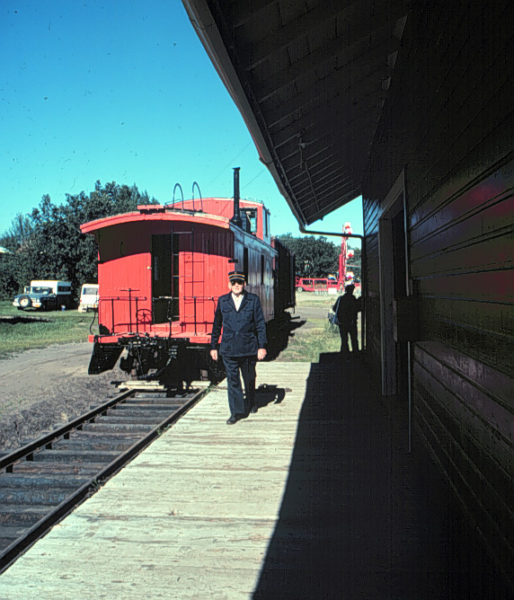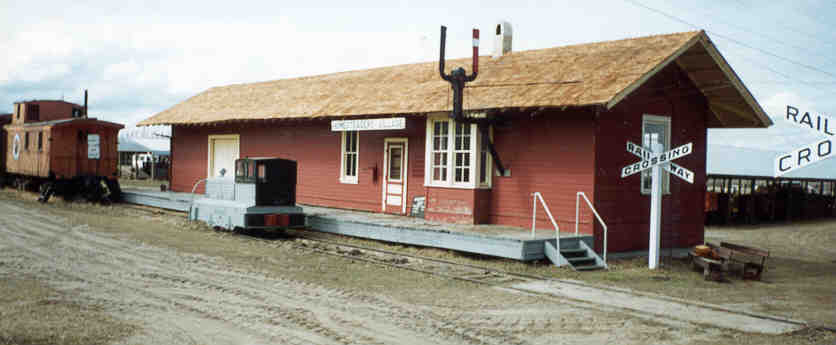
The railway station was originally built by the Northern Pacific & Manitoba Railway in 1890 to serve the community of Baldur. The station was moved to the museum in 1975.
The Northern Pacific and Manitoba Railway is not well known today and illustrates the complicated relationship between agriculture and railways in Manitoba and the Prairies in general.
The 1881 agreement between the Government of Canada and the Canadian Pacific Railway (CPR) for the construction of the railway stipulated the CPR was to enjoy a rail monopoly for 20 years. No railway could be built south of the CPR line. It is thought that this clause was to prevent another railway siphoning prairie traffic south to the US and practically guaranteed the CPR all the prairie traffic. In addition, the Government of Canada had stipulated that the CPR line was to remain on Canadian territory which meant the line had to cross Northern Ontario which offered little local traffic and so no revenue or profit.
The section of the railway from Calgary to the Fraser Valley was also expected to generate little local traffic and so little revenue or profit. As well, the Canadian Government was not prepared to offer an annual subsidy for the operation of the CPR. As CPR lines in eastern Canada faced competition from other railways plus water transport in the summer, rates in the east could not be increased to cover the losses incurred in operating across Northern Ontario. However as the CPR was the only game in Prairie transport, western freight rates could be safely increased. The 1883 CPR freight rate schedule set western rates at almost three times the eastern rates for movements of comparable distance. Prairie farmers were naturally upset that they had to pay such rates as they left little profit on grain for farmers. One must note that western wheat was, and still is, largely sold into the export trade where it faces completion from wheat from Australia, Argentina, the US and other countries. Prairie wheat prices have to be comparable to the prices from these countries meaning the cost of transporting prairie wheat to port cannot be easily passed on. So farmers absorb these costs and this is why grain freight costs were, and remain, a hot topic to farmers.
The Government of Manitoba was on the side of farmers and believed that high freight rates could be solved by competition for prairie movement from US railways. The Province issued provincial charters for railways however the Government of Canada disallowed such charters as not being in the interest of Canada. This situation persisted until the election of 1888 saw a Liberal, Thomas Greenway, installed as Premier of Manitoba. Greenway resorted to unilateral action, the threat of violence between provincial and federal authorities and the open defiance of the Federal Government and its policies. Greenway also approached the US for political and economic support on the Manitoba rail issue. This show of determination resulted in the Federal Government buying out the CPR monopoly, granting the CPR financial assistance to meet US railroad competition and abandoning the disallowance of provincial railway charters. The Manitoba government immediately built a line from the US border to Winnipeg and arranged running rights on this line with the Northern Pacific Railroad (NP) which was a major US railroad. The NP agreed to cut rail freight rates to 85% of the current CPR rates. The CPR lowered its rates immediately to meet the NP. By 1891, the Northern Pacific had set up a subsidiary Northern Pacific and Manitoba (NPM) to operate the line from the border to Winnipeg and had also acquired a charter to build a line west from Morris to Brandon.

However it became apparent the NP was really interested in making the CPR quit attempting to acquire traffic in the Puget Sound area of Washington State so cutting into NP traffic and profits there. NPM was a means to this end. CPR and NPM arrived at an understanding on rates and the Manitoba Governments dream of competition in rail freight rates went unfilled. NPM was never a profitable venture for the NP and by 1900 the NP wanted out. The lines were returned to the government who then sold them to the Canadian Northern Pacific (CNoP) which was rapidly expanding on the prairies at the time. The CPR was interested in acquiring these lines but this was unacceptable to the farmers and the politicians. As a result of the financial conditions of WW1, the CNoP declared bankruptcy and was later folded into the Canadian National Railway system. While the border to Winnipeg rail line remains active, the Morris, Brandon and west line was cut back over the years and the last remnants were lifted in the 2000s.
While an authentic railway station of Pioneer Manitoba, this station reflects more the US Northern Plains railway station design standards as it possessed no attached living quarters and was quite Spartan. Stations built by the Canadian Pacific, the Canadian National and its predecessor railways in western Canada usually incorporated living quarters as housing in many early communities was quite limited and the station agent could not be assured of obtaining a house or accommodation of some sort. CP in its early days did build quite plain stations and railways often used portable stations in new communities but as communities grew, new more elaborate stations were constructed. As competition grew between the CPR, the predecessor railways to the CNR and the CNR, station design began to pay close attention to aesthetics and the later CPR and CNR station designs were, for the time, attractive buildings.

The standard location for the railway station in a Pioneer community was at the head of the Main Street which usually ran at right angles to the rail line. On CPR lines this arrangement could vary. On Grand Trunk Pacific the layout of prairie communities on this rail line, now CN’s mainline across the prairies, was notoriously standard even down to having the names of communities and sidings on the line being named in alphabetical order.
The Baldur station was built long before electricity came into vogue. The station has been converted to electricity but still has the authentic brackets for coal oil lamps in its freight shed.
The station master issued passenger tickets, took orders for boxcars and other types of cars, kept track of cars in the yard associated with the station, handled less than car load freight (packages, boxes, cream cans, egg boxes, etc.) was responsible for operating the telegraph system in the station, noted the passing of trains and passed on train control messages to train crews, made sure the water tower was full for the steam engines and kept up the maintenance of the building and grounds.
The CPR, in particular, encouraged its agents to beautify the grounds as a means of promoting the Prairies. Some of their activities perhaps went too far as in the case of a senior CPR staffer who reputedly tied apples to a tree at Medicine Hat early in the spring for the passengers in passing trains to admire.


